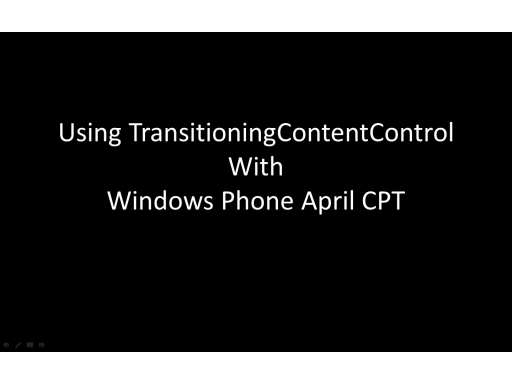Building Multiscreen Applications - Part 1 [MP4] [0:15:03] [2011/03/02]
[MP4] [0:15:03] [2011/03/02] This multi-part screencast series will look at the fundamentals involved in building multiscreen applications using Microsoft Silverlight and Visual Studio 2010. Starting with an overview of the…
Simple Dependency Injection with XAML [MP4] [0:11:10] [2011/01/19]
[MP4] [0:11:10] [2011/01/19] Have you ever wanted the flexibility of dependency injection without having to implement a full-blown IoC solution? Maybe you just want an easy way to pass concrete services to your ViewModel? This…
Three Reasons Developers Should Use Expression Blend [MP4] [0:13:58] [2010/10/16]
[MP4] [0:13:58] [2010/10/16] Lots of developers are building XAML-based applications today. Be it WPF, Silverlight or Windows Phone 7, I have seen a lot of people struggle with certain tasks in Visual Studio that would be much…
Managing Windows Phone 7 Trial Applications [MP4] [0:12:07] [2010/08/31]
[MP4] [0:12:07] [2010/08/31]
Windows Phone 7 provides the LicenseInformation class that includes the
IsTrial() method. IsTrial() allows you to check, at runtime, if the running application has been installed from the…
Custom Per-Page Transitions for Windows Phone 7 [MP4] [0:10:18] [2010/06/08]
[MP4] [0:10:18] [2010/06/08]
Continuing our previous explorations of the TransitioningContentControl (here and
here – all WinPhone content
here), we will now take a look at how we can extend the TCC to allow transitions to…
Windows Phone 7 April CTP and TransitioningContentControl [MP4] [0:05:41] [2010/05/21]
[MP4] [0:05:41] [2010/05/21]
In my original screencast (my blog or on
here on Channel 9), I showed you how to use the Silverlight Toolkit’s TransitioningContentControl to add automatic transitions between pages of your…
Simplify Page Transitions in Windows Phone 7 Silverlight Applications [MP4] [0:14:30] [2010/04/30]
[MP4] [0:14:30] [2010/04/30]
Update: To see how to extend this solution for custom per-page transitions, see
my follow-on article.If you have played around with Silverlight on Windows Phone 7, one thing you may have tried to…
Peer to Peer Series Part 7: PeerChannel Basics [MP4] [0:12:36] [2009/12/11]
[MP4] [0:12:36] [2009/12/11]In Part 7, I introduce the basics of building a WCF PeerChannel application. Using a simple console application, the following steps are shown:
Creating the necessary interfaces Setting up the WCF…
Peer to Peer Series Part 6: Introduction to PeerChannel [MP4] [0:09:45] [2009/11/07]
[MP4] [0:09:45] [2009/11/07]In Part 6 of the Peer to Peer Series, I set the stage for learning how to use WCF's PeerChannel. After a simple overview of PeerChannel, I show a sample application that uses PeerChannel to play…
Peer to Peer Series Part 5: Direct Connect Peers via WCF [MP4] [0:18:02] [2009/10/09]
[MP4] [0:18:02] [2009/10/09]
In Part 5 of the Peer to Peer Series, I show a sample application that uses PNRP to connect a client application to a server application using WCF and PNRP Peer Host Names. The details of the actual…
[Peer-to-Peer-Series-Sample-WPF-PNRP-Application]
Peer to Peer Series Part 4: Resolving Peer Names Asynchronously [MP4] [0:05:27] [2009/09/18]
[MP4] [0:05:27] [2009/09/18]
In Part 4 of the Peer to Peer Series, I modify the Resolve program to find Peer Names using the asynchronous methods. Below is a very simple example of using the ResolveAsync method:…
Peer to Peer Series Part 3: Resolving Names Synchronously with the PNRP API [MP4] [0:07:42] [2009/09/18]
[MP4] [0:07:42] [2009/09/18]
In Part 3 of the Peer to Peer Series, I add another Command Prompt application to the demo solution and use the PNRP API to resolve a Peer Name using C#. As with registering a Peer Name, resolving…
Peer to Peer Series Part 2: Registering Names with PNRP API [MP4] [0:08:52] [2009/09/18]
[MP4] [0:08:52] [2009/09/18] In Part Two of the Peer to Peer Screencast series by SlickThought Productions, we look at using C# and the PNRP API to register a peer name. This example uses a simple Command Prompt application to…
Peer to Peer Series Part 1: Intro to PNRP [MP4] [0:17:12] [2009/09/18]
[MP4] [0:17:12] [2009/09/18]This kick-off screencast introduces you to the foundation of Peer-to-Peer applications, PNRP. Peer Name Resolution Protocol is the the underlying mechanism used by applications to discover peers on a…













